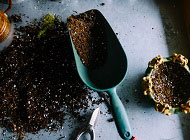 Purchasing potting mix can be overwhelming especially for first-timers. With so many options, a gardener or nursery worker will be confused about which one is best to be used for their plants.
Purchasing potting mix can be overwhelming especially for first-timers. With so many options, a gardener or nursery worker will be confused about which one is best to be used for their plants.
Choosing the right potting mix is crucial. This is because all the water and nutrients needed by plants come from its potting mix. On top of that, different potting mixes are formulated to respond to the plant’s certain needs. Knowing the appropriate potting mix to use will allow gardeners and nursery workers to give their plants what they need in order to be healthy.
To help you with selecting the best potting mix, we have created a quick guide on how to choose them. Read here to learn more.
What makes a good potting mix?
A good potting mix should provide plants with the best growing medium. Compared to plain soil, potting mixes have the appropriate size of air pockets for the roots to grow. Aside from that, they contain all the moisture and nutrients that a plant needs to thrive.
Below are some of the things to be considered when looking for an appropriate potting mix.
-
The right potting mix ingredients
The key to choosing a good quality potting mix is to understand its ingredients. A lot of potting mixes in the market today are comprised of three main ingredients. These are pine bark, peat moss and vermiculite or perlite. These ingredients have their own benefits to the growing plants.
a. Pine bark
Pine bark is from paper mills that provide moisture and fertilization retention to plant. They can also provide a bit of air space in the soil. But using pine bark alone is not enough to support plant life. Thus, it should be mixed with other ingredients like peat moss to make it more effective as a potting mix. It can also help extend the lifespan of the potting mix.
b. Peat moss
Peat moss provides great moisture-retaining properties and good air space for growing plants. It can also retain its moisture for a long time after watering it. Like pine bark, using peat moss alone can be too much acidic for the plants.
c. Vermiculite and Perlite
Vermiculite and Perlite are both volcanic in origin. Hence, they are high in nutrients and good for plants. These ingredients can give additional air space to the potting mix so that it is not dense.
-
Potting mix with fertilizer
A good potting mix is generally infused with either a “starter charge” of fertilizer or slow-release fertilizer.
A fertilizer with a “starter charge” means that there is a small amount of fertilizer added into the potting mix. Although it already contains a minimal amount of fertilizer, it still needs to be fertilized regularly. Moreover, most fertilizers with a starter charge are gone from the potting mix after two or three times of watering.
Contrarily, a slow-release fertilizer means that the potting mix contains more fertilizers. But this fertilizer only lasts for a month.
-
Plant location and Moisture-retaining treatments
The location of the plants in the nursery influences the choice of potting mix. Plants that are placed under a shade usually don’t lose water quickly. With that, gardeners can use a lighter potting mix for these plants.
On the other hand, plants that are exposed to the sun need some medium weight potting mix. This type of potting mix holds water well.
Furthermore, if the gardeners or nursery workers are unable to water their plants regularly, a potting mix with water-absorbing gel can be used.
A lot of potting mixes nowadays come with moisture-retaining gels and chemicals. With these “moisture retainers”, gardeners can skip watering their plants for the first three weeks of usage.
A quality potting mix according to Australian standards
When picking a bag of quality potting mix, make sure to choose the one that has an Australian Standards set of ticks on it.
Usually, it is a logo with a row of 5 ticks (check marks). These standards have been developed by non-government organizations. They are applied to various potting mixes that have been individually verified and passed a series of criteria.
Here are the set of criteria that they use:
- how well the potting mix drains
- its ability to hold and absorb water
- the number of nutrients present in the potting mix
- an appropriate pH level
From these criteria above, they come up with two standards of potting mixes. These are as follows:
Regular (black ticks) – This is considered to be the basic standard of potting mix. Regular potting mixes are ideal to use for general purposes. This is because they work well for growing short-term plants or fast-growing vegetables.
Premium (red ticks) – This is a high-standard potting mix. They are the first option for those who want the best for their plants.
They are great for long-term container plants. Most premium potting mixes contain nitrogen. Thus, they don’t need additional fertilizer to grow plants. However, they are more expensive than any other potting mix.
Conclusion
Choosing the right potting mix for plants may not be an easy process. This is because certain plants require a specific potting mix to grow and thrive. Thus, understanding the basics of a potting mix can help gardeners and nursery workers choose the best ones for their plants.
If you need nursery and gardening equipment for handling various potting mixes, feel free to approach a reliable nursery equipment vendor in Australia.







